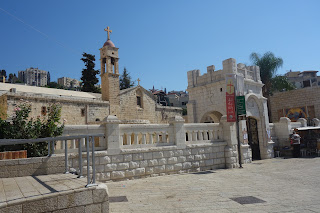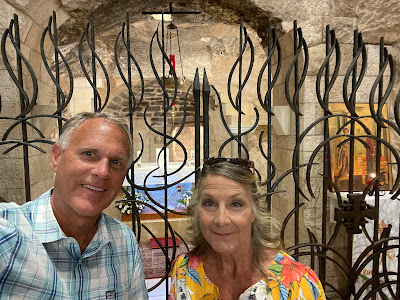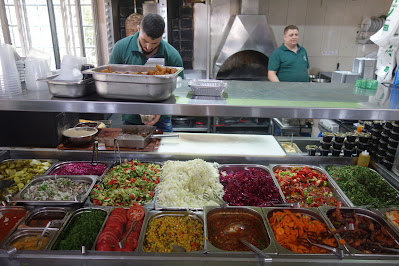On Friday, September 9, we were docked back at Haifa, Israel. For our last day in the Holy Land, we arranged for a private tour "In the Footsteps of Jesus", which would take us to Nazareth and the sea of Galilee areas in the north. But first, we asked our guide to give us a glimpse of Haifa. One of the most prominent features on the hillside of Mount Carmel, is the green landscaping of the Baháʼí Faith's Baháʼí World Centre, which is a UNESCO World Heritage Site. But from the top of Mt. Carmel, we had extensive views of the beautiful city and bay. Haifa is the third largest metropolitan city in Israel, with a settlement history of more than 3,000 years. Israeli Jews comprise some 82% of the population, almost 14% are Christians (the majority of whom are Arab Christians) and, some 4% are Muslims.





We drove to Nazareth, which was the home of Jesus, although it is now a cultural, political, religious, economic and commercial center for the Arab citizens of Israel. Little remains to inspire the feel that is found in Bible stories. We stopped for a moment, in the middle of town, at Mary's well, believed to be the site of the Annunciation. The angel Gabriel is said to have appeared to Mary at this site to tell her she would be the mother of the Son of God.
Two, maybe even three sites are popularly known as Mary's Well – the spring underneath the Greek Orthodox Church of the Annunciation, St. Gabriel Church, the well structure in the plaza 50 yards to the south of it (just shown), and a presumed spring underneath the Basilica of the Annunciation. We visited St. Gabriel Church which was just across the road. They also have a well in their courtyard which they claim as Mary's. Below the church there is an underground chapel from the medieval era containing the spring. Beautiful modern decorative murals cover the walls and the ceilings of the 18th-century overground church.
The path to the underground chapel and the spring which fed Mary's well.
We left the orthodox church and walked through Nazareth where we saw many businesses tucked away in alleyways. Palestinian's were not afraid to display their perceived persecution by the Jews. We took a few minutes to look at a gift shop and the many crafts made locally.
Another short walk down the street and we saw more everyday life in Nazareth. It wasn't far to reach the Catholic Basilica of Annunciation.
The large and impressive Catholic Basilica of Annunciation is a lot to take in upon first sight. Completed in 1969, it was the largest Christian church in the Middle East.
The beautiful courtyard is a gallery with icons (mainly mosaics, but also some made of ceramic tiles) representing some of the most important Marian devotions in different countries. It was so interesting to see each culture represented in their art style. It reminded me of a collection of nativities on display at Christmas in the states.
The lower level of the church contains the Grotto of the Annunciation, believed by many Christians to be the remains of the childhood home of Mary.
The upper level chapel displays more pictures of Mary from countries with significant Catholic membership. I found the one from the United States to be quite harsh (almost devilish) compared to others - especially the beautiful mosaic from Japan.
Just outside the Basilica, underground excavations were being conducted to discover Biblical Nazareth ruins.
Our guide suggested we stop in to a typical regional bakery and enjoy some varieties of baklava and a Middle Eastern dessert originating from Nazareth called Knafeh, which is a traditional sweet made with shredded phyllo dough, filled with a sweet cheese, and soaked in a sugar syrup. It's considered a local delicacy and it was delicious!
We left the city of Nazareth and began our drive toward the Sea of Galilee. We stopped and enjoyed a delicious lunch along the way.


















































































No comments:
Post a Comment